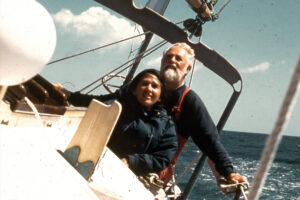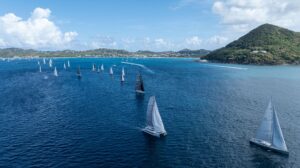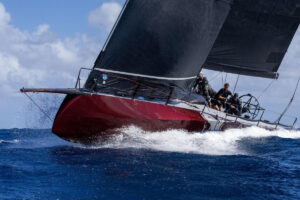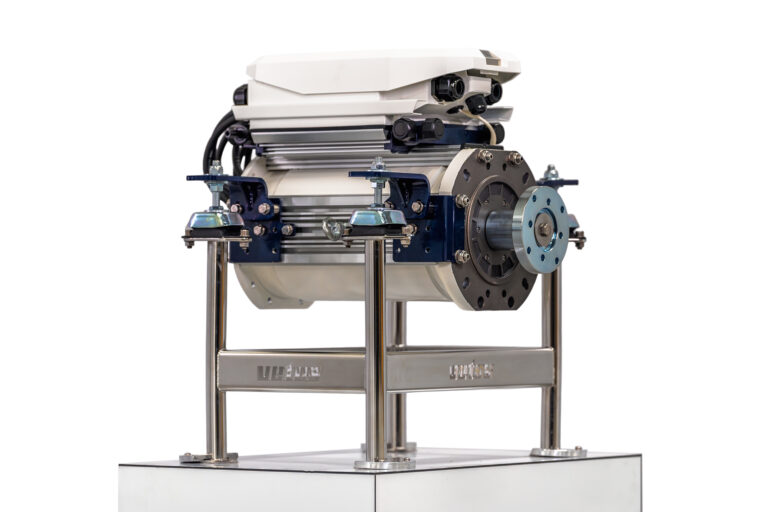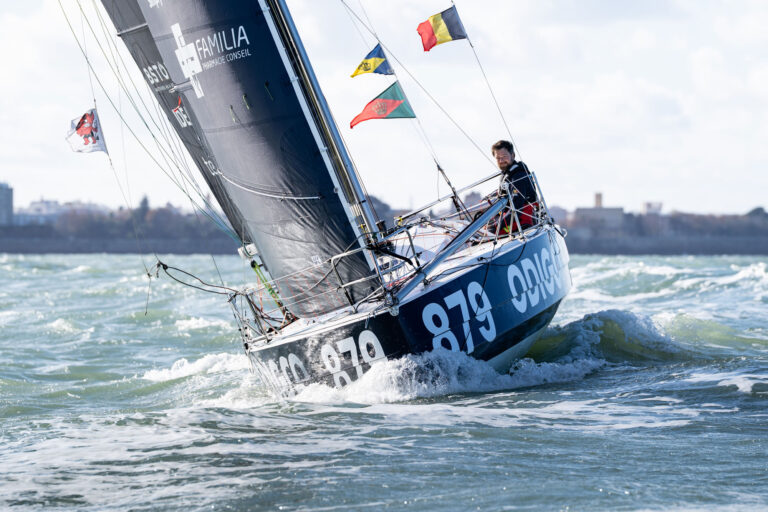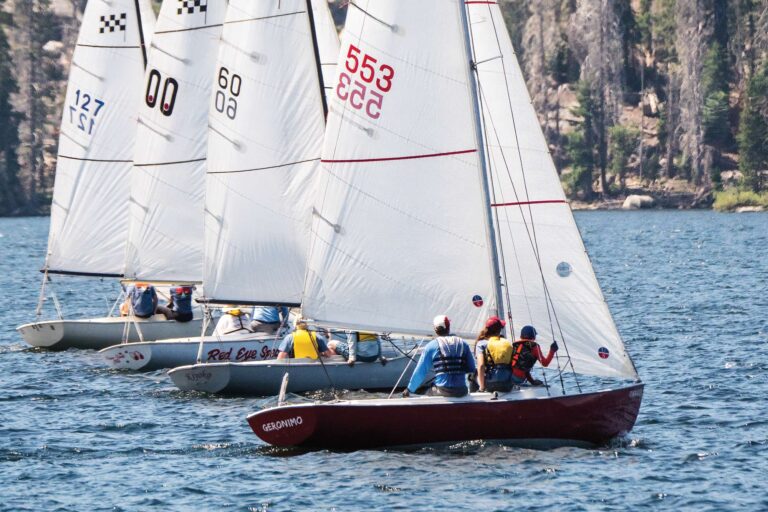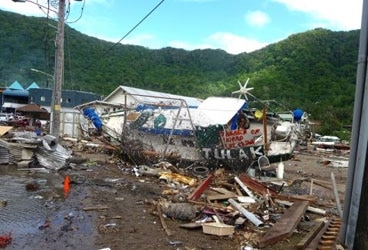
One of the many boats washed ashore in Pago Pago, American Samoa.
At 1748 UTC (approximately 7 a.m. local time) on September 29, 2009, a magnitude 8.3 earthquake struck at a depth of 33 kilometers in the Pacific Ocean at 15.3 S and 171.0 W, 80 nautical miles south of American Samoa and 160 nautical miles northeast of Niuatoputapu, Tonga.
Crews of cruising yachts moored in Pago Pago, American Samoa, were awakened by the three-minute long quake, which seemed, in the words of many, to “last forever.” There was apparently much discussion at the public dock among cruisers about finding internet reports of the earthquake, but in their searches no one uncovered the tsunami warning issued by the Pacific Tsunami Warning Center.
The warning, time stamped 1804 UTC, was released 16 minutes after the quake and indicated that a tsunami could reach Pago Pago in only 11 minutes (or 5 minutes before the warning was issued). Eyewitness reports indicated that the tsunami began its assault on Pago Pago 20 minutes after the quake or approximately 4 minutes after the first warning was released. No warning sirens have been reported in Pago Pago prior to the tsunami and this caught many unprepared. Many cruising yachts in Pago Pago suffered significant damage.
West, In Apia, on the island of Upolu, Samoa, sirens began wailing soon after the quake struck, giving cruisers like Ernie and Charlene Kelly of the 38-foot catamaran Lauren Grace an opportunity to cast off dock lines and go to sea before the worst of the tsunami turbulence hit the shallow harbor.
The crews of two other boats, including Nick Jaffe of the Contessa 26, Constellation, and John and Amanda Neal of Mahina Tiare III (for updates and photos of the devastation from the Neals log on to www.mahina.com/newsletter.html), chose to stay and wait, watching docks surging and fish being thrown ashore. These cruisers were ordered by police to higher ground under threat of arrest, leaving their boats in the marina unattended as the harbor waters receded, leaving dry ground in its wake. Some watched the drama unfold from the third floor of Aggie Grey’s hotel. Apparently, these boats suffered no significant damage.
In Niuatoputapu, the principal island of Tonga’s northern group of the same name, the earthquake and the tsunami were almost simultaneous. Taremaro, a Dutch-flagged steel Caroff 38, with Rob and Marjo Eichelsheim aboard, reported that departing boats already in the pass at the time of the quake struggled desperately to go to sea to avoid being swept onto the exposed reef as the tsunami emptied the bay.
Farther south, in the Vava’u group of Tonga, docks were swept away in Neiafu and local boats lost. Tom and Monique Burgess aboard the 48-foot catamaran, Zen, with their children, Cameron and Cole, report that some boats anchored in outer islands of the archipelago experienced significant tidal changes-8 feet or more-with rapid currents, and at least three cruising boats were momentarily grounded and then quickly refloated during the mayhem.
Cruising boats at isolated atolls, such as authors Leslie Linkkila and Philip DiNuovo aboard Carina, a Mason 33 anchored at low lying-Suwarrow in the northern Cook Islands, reported no visual indication of the tsunami, though the wave did pass through the area. The much-admired Cook Islands family who are caretakers of Suwarrow and who look after cruising visitors-John, Veronica, and their four handsome boys, are safe.
At Beveridge Reef, a true atoll with no motus and no reef projecting above water, seven boats miraculously survived the tsunami unscathed. Alene Rice and Bruce Balan aboard Migration, a Cross 46 trimaran, reported all seven boats left the atoll and made for Nuie upon learning of the tsunami. Earlier, at Nuie, Rob and Teresa Sicade of Yohelah, a Baba 40, were evacuated by government officials from the moorings and forced to sea to avoid the danger. As far away as Ua Pou in the Marquesas, John Grafton and Linda Hill cruising aboard Nakia, a Hans Christian 33, were ordered to sea by the local gendarmes.
Devastation in Pago Pago
The stories from Pago Pago are the most telling of the violence of a tsunami and the damage it caused. Kirk McGeorge, with his wife, Catherine, and son Stuart of the Hylas 47 Gallivanter, were aboard and online the internet, researching the earthquake when the tsunami struck. “All hell started breaking loose!” Kirk recalls. “People were screaming!” He reports the harbor waters began to surge and then to ebb rapidly, draining dry the areas around the dock, causing their boat to topple on its side on the mud and three of their large dock lines to snap. Just as fast, waters returned, washing Gallivanter up above the dock where they could see people clinging to light poles desperately trying to avoid getting swept away, and other yachts trying to get under way. Catherine sawed through the remaining dock lines with a bread knife and under full power, Gallivanter motored clear of the dock and into a harbor littered with dangerous debris.
The billions of gallons of ocean water squeezing into the steep-to Pago Pago harbor caused flooding of 25 feet or more at the head of the bay and far into town. Cars, containers, docks, wrecks, garbage, and the remains of buildings swirled around violently, threatening the boats that were under way trying to stay out of harm’s way. At least one cruiser and friend of many, affable Dan Olszewski of the Freedom schooner Mainly (for more details, log on to the story in the St. Petersburg Times ), was swept into the sea and drowned while trying to fend his boat from the pier. His lovely wife Joan, frantic, kept Mainly afloat during the flooding, all the while trying to locate Dan. His body was later recovered.
Boats were under way everywhere, not only the cruising yachts, but also derelict fishing boats for which Pago Pago seems to be a graveyard. Caribee, with Randy and Cheryl Baker aboard, was sucked inland and they tried desperately to get back to the harbor by motoring in the waters flooding the park and the soccer field.
They were successful, but were hit amidships by two large abandoned fishing vessels and lost their bowsprit, a portion of their cap rail, and much of their rigging. Meanwhile, an Australian- flagged Irwin 52 ketch, Biscayne Bay, was swept to sea without crew-Garry and Lisa Cross with son Jacob and crew Chris-and is nearly destroyed. Sunshine, a small Coronado sloop, remains on the rocks with the deck above its compression post severely damaged and its mast and rigging on the ground.
An amazing story is that of Tulak, a classic Pearson 35 yawl with single-hander Stephen Brasa aboard. Powered only by an outboard engine, Stephen was unable to steer clear of danger and was swept literally down Main Street, Pago Pago, taking utility poles and telephone wires in his wake. Sadly, when the waters receded, Tulak came to rest far inland from the sea and has been deemed unsalvageable. Stephen’s home and dream are destroyed, though he escaped injury.
Aftermath
Joe Bayne and Dubis Blanca of the vessel Jubilee, a Corbin 39, who were able to clear their anchor quickly enough to save their boat from the tsunami’s floodwaters, have reported that in Pago Pago, Samoans are busy at work restoring order. Government and private offers of help have been extended to the cruising community and those in significant need are receiving it.
Meanwhile, cruisers have mobilized to help and are on the scene at Niuatoputapu, Tonga led by the Swedish yacht, Panacea, with owners Agnes and Bertil Mattsson aboard. Three other New Zealand yachts are assisting to provide food, water, clothing, and fuel to the devastated island. Supplies to this island were already 5 months overdue, due to a recent ferry/supply ship disaster that killed 100 of the island’s people. Niuatoputapu lost two of its three villages and its supply pier to the tsunami.
Cruising yachts are departing Apia and Neiafu en route there, bringing food supplies and additional help. George Hill and Kathleen Whitney of the 43-foot sloop Kalalau are involved in this relief effort and offered this comment: “This [response] is what makes cruisers so GREAT!”
More
Follow the account of Wayne Hodgins aboard Learnativity, his 50-foot steel monohull cutter, in Pago Pago at his website (www.learnativity.typepad.com).
To see images by sailor and photographer Kimball Corson ().

